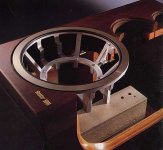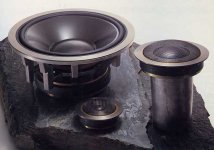Hello, has anybody experimented with "floating" the driver within the box? Some type of mechanism needs to be devised to push or pull the driver, as minimally as possible against he baffle to seal it. Or does it even matter if the driver is held by its magnet and then mounted to the bottom of the box?
Badman, what were the sonic differences between your mounting method and mounting conventionally? Thanks.
Badman, what were the sonic differences between your mounting method and mounting conventionally? Thanks.
I would love to see a copy of that if you find it.
dave
I've dug around and can't find the Fryer paper other than as referenced by Toole. The paper is "Intermodulation Distortion Listening Tests" JAES vol23 p402 June 1975.
As quoted by Toole: "More recently, Fryer reported a detailed determination of the detection thresholds for resonances added to different program material." "Based on this measure, one concludes that the listeners were most sensitive to resonances of low Q, with the detectability decreasing approximately 3dB for each doubling of the Q value. It was also found that all resonances were most easily heard with whte noise as a test signal, with reduced sensitivity when using classical (symphonic) music, and with much reduced sensitivity when using popular music." "As judged by their maximum steady-state levels, low-Q resonances, producing broad peaks in the response curve, are more easily heard than high-Q resonances thar result in quite narrow peaks. A resonance with Q = 1, for example, can be heard in noise when its maximum steady-state level is 25 dB below the spectrum level of the program, while one with Q = 50 can approach to within 10 dB (even less at low frequencies) of the spectrum level before being heard." From "The Modification of Timbre by Resonances" JAES Vol 36 no.3 March 1988.
Again, these are resonances made by electrical means and sidestep the fact that, in mechanical systems, level will change with Q.
David
Thank you for the reference !
The direct transfer of the data from systems which hold the peak
at a constant level to passive resonators (like loudspeaker cabinets),
which don't, seems in fact to be the crucial point.
The description "low-Q resonances, producing broad peaks in the response curve, are more easily heard than high-Q resonances that result in quite narrow peaks" leads simply astray when applied to a passive resonator.
Even if correct and plausible under that experimental setting.
Not a surprise, that this finding causes debates.
The direct transfer of the data from systems which hold the peak
at a constant level to passive resonators (like loudspeaker cabinets),
which don't, seems in fact to be the crucial point.
The description "low-Q resonances, producing broad peaks in the response curve, are more easily heard than high-Q resonances that result in quite narrow peaks" leads simply astray when applied to a passive resonator.
Even if correct and plausible under that experimental setting.
Not a surprise, that this finding causes debates.
The paper is "Intermodulation Distortion Listening Tests" JAES vol23 p402 June 1975.... "The Modification of Timbre by Resonances" JAES Vol 36 no.3 March 1988.
Thanx. Another reason to spend some time ordering my Journals... they go back to before the earliest one mentioned.
dave
Since cabinet damping and mechanical decoupling do not exclude
but can be combined, my preferred "archetypical" solution would look
pretty much like the "Eclipse" posted by planet10 in post #4.
How to manufacture, where to damp etc. is up to everyones own
creativity i guess ...
If the woofer has enough mass even standard industrial rubber-metal
bumbers may work.
Important is to have the woofer-supension resonance far enough below
the usable system resonance and to have its Q low enough.
Otherwise the thing might get beasty when "techno" LF excited.
but can be combined, my preferred "archetypical" solution would look
pretty much like the "Eclipse" posted by planet10 in post #4.
How to manufacture, where to damp etc. is up to everyones own
creativity i guess ...
If the woofer has enough mass even standard industrial rubber-metal
bumbers may work.
Important is to have the woofer-supension resonance far enough below
the usable system resonance and to have its Q low enough.
Otherwise the thing might get beasty when "techno" LF excited.
From what I've read in both this thread and other thread on cabinets and materials, it would be good if :
1) the driver does not move
2) the enclosure does not vibrate
3) achieving both is difficult
What I've read about visco-elastic materials, resonant frequencies, vibration dampenig by granular materials and material properties, I think that a modified box within a box approach could achieve points 1 and 2 above.
I'm thinking you mount the drivers solidly into a box with no back surface. This box should be rather massive and rigid. This box then "floats" within a box with no front. Now the "floating" part doesn't actually allow the first box to move measurably since the the boxes are coupled by a visco-elastic glue (somehting like Green Glue or Noise Killer Yellow) which turn the vibrations into low level heat. I'd actual create a third box again without a front that would be the innermost layer of the 3 layer wall.
Additionally any internal bracing for the sides and back can be rigidly attached to the innermost box while the bracing for the front baffle is rigidily attached to front baffle only and again flosts with the side/back bracing. The front baffle bracing could also be terminated within a compartment filled with a low density, low speed of sound granular material that also dampens the vibrations.
1) the driver does not move
2) the enclosure does not vibrate
3) achieving both is difficult
What I've read about visco-elastic materials, resonant frequencies, vibration dampenig by granular materials and material properties, I think that a modified box within a box approach could achieve points 1 and 2 above.
I'm thinking you mount the drivers solidly into a box with no back surface. This box should be rather massive and rigid. This box then "floats" within a box with no front. Now the "floating" part doesn't actually allow the first box to move measurably since the the boxes are coupled by a visco-elastic glue (somehting like Green Glue or Noise Killer Yellow) which turn the vibrations into low level heat. I'd actual create a third box again without a front that would be the innermost layer of the 3 layer wall.
Additionally any internal bracing for the sides and back can be rigidly attached to the innermost box while the bracing for the front baffle is rigidily attached to front baffle only and again flosts with the side/back bracing. The front baffle bracing could also be terminated within a compartment filled with a low density, low speed of sound granular material that also dampens the vibrations.
I think the hard part is overcome one's inhibitions on that
and tolerate the driver moving at a defined frequency < fs ...
With an fs of 30Hz, i cannot see the problem with the driver basket
moving at fd say 10Hz and a Q of say up to 2.
If you do not design for movement there is no decoupling, is there ?
May be it is counterproductive in fact to overdue damping in the
decoupling resonator (driver basket suspension), because
the decoupling might miss the 12db/octave target then ...
So before building very complex and costly i would "let it swing"
and see what happens.
I would expect a proper aligned decoupling resonator combined
with a well damped cabinet to have an extraordinary clean bass
reproduction. Which can otherwise only be reached with
"mass compensated" drivers acting in opposite direction and fixed
directly to each other to keep the cabinet calm.
and tolerate the driver moving at a defined frequency < fs ...
With an fs of 30Hz, i cannot see the problem with the driver basket
moving at fd say 10Hz and a Q of say up to 2.
If you do not design for movement there is no decoupling, is there ?
May be it is counterproductive in fact to overdue damping in the
decoupling resonator (driver basket suspension), because
the decoupling might miss the 12db/octave target then ...
So before building very complex and costly i would "let it swing"
and see what happens.
I would expect a proper aligned decoupling resonator combined
with a well damped cabinet to have an extraordinary clean bass
reproduction. Which can otherwise only be reached with
"mass compensated" drivers acting in opposite direction and fixed
directly to each other to keep the cabinet calm.
Last edited:
...
May be it is counterproductive in fact to overdue damping
...
Should read: "Maybe overdamping is counterproductive ..."
Hello, has anybody experimented with "floating" the driver within the box? Some type of mechanism needs to be devised to push or pull the driver, as minimally as possible against he baffle to seal it. Or does it even matter if the driver is held by its magnet and then mounted to the bottom of the box?
Badman, what were the sonic differences between your mounting method and mounting conventionally? Thanks.
The impression of space is improved, and there's an airiness to the presentation. Better transient delineation and more low level detail, it seems.
You know.... the good stuff 🙂
Mechanically de-coupling the driver from the enclosure
Just found this thread - I tried this approach some time ago with full-range drivers. I used E-A-R elastomer grommets to mount the drivers (avoiding 'shorting' the mounting bolt to the driver frame) and a sorbothane gasket to provide an air-tight well-damped seal between the driver and the air enclosed by the cabinet.
The result was that my crude stethoscope test (put the stethoscope on the enclosure and listen!) showed a MUCH quieter enclosure with much reduced transmission of energy from the driver to the enclosure. Great!!
However, the resultant speaker didn't sound very different compared to the tight mounting I used at the outset. Hmmmmm - I'd acoustically isolated the driver from the enclosure, but without great sonic benefit. It made me wonder of other distortions have a greater effect. Onward !!!!!!
Just found this thread - I tried this approach some time ago with full-range drivers. I used E-A-R elastomer grommets to mount the drivers (avoiding 'shorting' the mounting bolt to the driver frame) and a sorbothane gasket to provide an air-tight well-damped seal between the driver and the air enclosed by the cabinet.
The result was that my crude stethoscope test (put the stethoscope on the enclosure and listen!) showed a MUCH quieter enclosure with much reduced transmission of energy from the driver to the enclosure. Great!!
However, the resultant speaker didn't sound very different compared to the tight mounting I used at the outset. Hmmmmm - I'd acoustically isolated the driver from the enclosure, but without great sonic benefit. It made me wonder of other distortions have a greater effect. Onward !!!!!!
- Status
- Not open for further replies.
- Home
- Loudspeakers
- Full Range
- Mechanical isolation of driver from cabinet

